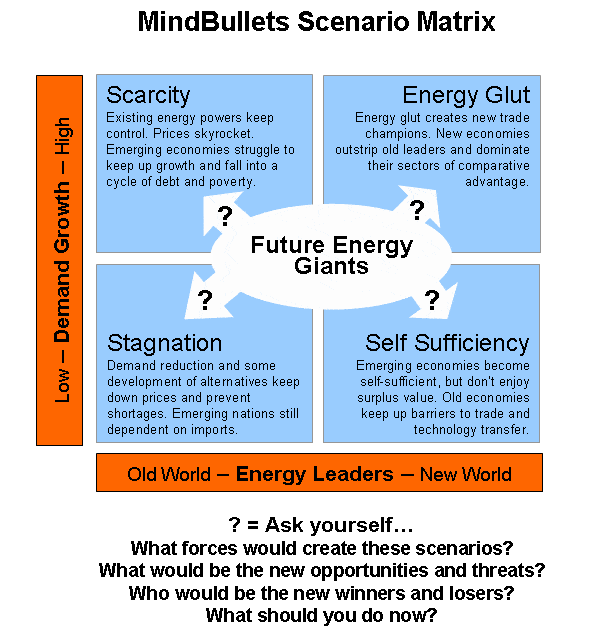
Energy glut creates new trade champions

Rich nations on the back foot as energy floods emerging economies
- Dateline
- 7 March 2019
The end of the oil age has heralded a glut in energy worldwide; but surprisingly the developing nations have been the first to benefit. While solving the ‘energy crisis’ that faced the old economies a decade ago, technology has leap-frogged emerging economies into the forefront of production and trade.
Energy costs, particularly fuels for transport and manufacture, have been key in the development of the industrial age and advancing the first world to its present status. But the insatiable demand for oil and electricity that characterizes the world’s richest nations led to rapid technological innovations that could exploit new sources of energy – renewable, inexhaustible – and ultimately cheaper.
Developing nations, with their rapid growth, were forced to consider their resource limitations, and quick to adopt the new technologies for cheaper energy – often a deciding factor in maintaining their growth rates.
Now they have turned the tables on the old world leaders. With greater efficiencies and economies of scale, the third world is first in manufacture and export – not only goods and services, but the very technology of new energy sources.
ANALYSIS >> SYNTHESIS: How this scenario came to be
Future Fuels
In the long run we may see entirely new energy technologies [in addition to biofuels].
The University of California’s Kammen thinks it’s possible to add extra batteries to today’s gasoline-electric hybrid cars to create plug-in hybrids that can be recharged at home, the office, and the mall. Such cars might be able to go 200 to 300 miles (320 to 480 kilometers) on a gallon (3.8 liters) of gas, he says. Already, an organization called CalCars is at work on this project.
Kammen is also a fan of wind power and rooftop solar generators. “There are parts of northern Germany that already get a quarter of their electricity from wind. In a good month they get 50 percent,” Kammen said.
Another prospect is methanol, which can be made from natural gas. And, unlike hydrogen, it’s easy to store and transport. In the future green electrical power could be used to make methanol from recycled carbon dioxide. Such a technology would not only provide fuel but also ease global warming, since carbon dioxide in the atmosphere is known to trap heat.
(from National Geographic News)
Another promising technology is the fuel cell. While hydrogen fuel cells are efficient but problematic, fuel cells are being developed that run on methanol, glucose, and even sewage. The latter could be an important source of green electricity for the production of liquid synthetic fuels such as diesel from natural gas. And Peugeot-Citroen have already demonstrated prototypes of diesel-electric hybrid cars that get 69 miles to the gallon (3.4 liters per 100km).
A hybrid fuel technology is also being pioneered in Malaysia, where some of the excess power from a gasoline engine is used to separate water into hydrogen and oxygen. The hydrogen is then fed into the fuel intake of the combustion engine, effectively doubling the mileage obtained from a tank of gasoline. This concept could be extended to a hybrid vehicle that uses ethanol or methanol to fuel both a combustion engine and on-board fuel cells – eliminating the need to ‘plug in’ to recharge batteries when the vehicle is stationary.
The barriers to unlocking these technologies are purely economic. Four developing economies provide clues to the fuels of the future: Brazil, South Africa, India and China.
2004: Synthetic fuel from Africa
South Africa becomes the largest exporter of technology for the creation of synthetic fuels with billion-dollar deals signed with Chevron and Qatar by Sasol. Sasol has been producing oil from coal for years, currently supplying over 40% of South African requirements. Recent advances in the field of gas-to-liquid synthesis offers the opportunity to exploit the vast untapped gas reserves such as those held by Qatar in years to come.
2005: Biofuel from Brazil
Brazil becomes the leading producer and exporter of ethanol, produced mainly from sugar cane. At least 20% of the country’s gasoline needs are met with ethanol. “More than 40% of Brazil’s energy comes from ‘green’ sources, in comparison with around 7% in rich countries, says president Luiz Inácio Lula da Silva. “The ethanol Brazil produces from sugar cane is attracting worldwide interest, for it is one of the cheapest and most dependable types of fuel derived from renewable sources. Three-quarters of the cars now being produced in Brazil have ‘flex-fuel’ engines, capable of running on either ethanol or petrol, or any mixture of the two.”
India has mastered nuclear power and is developing biodiesel from Jatropha plants.
2006: China goes shopping
China’s growth and rapid adoption of the middle class western lifestyle – private automobiles – has resulted in an increased reliance on imported oil as well as other resources. China seeks to tie up oil contracts from Iran to Nigeria.
But China has a hidden asset up its sleeve. Even as energy experts predict that the world has less than 80 years reserves of oil, China boasts coal reserves of at least 400 years, as well as huge reserves of dollars. China is in a position to exploit South African technology to more productively use its coal deposits for liquid fuel, as well as develop cleaner and greener methods of producing power from coal.
In his State of the Nation address, George W Bush calls for a concerted effort to reduce dependence on Middle East oil, and holds up cellulosic ethanol as the biofuel of the future. Ironically, entrepreneurial Canada will be the first to benefit from the growth of this industry.
India signs a deal with the US to further develop nuclear power. “If we are to rid ourselves of the scourge of poverty, demand for energy will at least double in the next 20 years,” says India’s former Energy Minister Mani Shankar Aiyar.
2007: Crises create solutions
Caught unawares by a greater than expected economic growth rate, South Africa is facing a looming energy crisis – electricity demand will exceed capacity within a matter of years. Plans for the as yet unproven Pebble Bed Modular Reactor are accelerated and more government support given to Sasol’s gas conversion processes. Nearby Mozambique proves to be a valuable source of gas.
2009: Ethanol powers fuel cells
Brazil exploits its massive ethanol production capacity to take advantage of new fuel cell technology which converts ‘watery’ ethanol to electricity – with greater efficiency than methanol fuel cells, and at lower cost. Clean ‘alcohol power’ becomes the latest green energy source. Mauritius, which has been gearing up its ethanol production, is quick to capitalize on these new developments.
India’s extensive electrification program has allowed it to radically extend its telecommunications and broadband infrastructure, along Malaysian lines, and improve education. India puts its considerable software expertise and cheap skilled labour behind improving biodiesel extraction and nuclear power generation. Biotechnology breakthroughs yield improved strains of Jatropha and better quality fuel.
US efforts to promote cellulosic ethanol are still in the early stages, and prove to be highly capital intensive.
2012: China stops buying fossil fuels
China announces a long term program to remove all dependence on ‘fossil’ fuels. However, with typical Chinese ambiguity, these declarations refer only to oil-derived liquid fuels for automotive transport and avoid any reference to power generation. Coal remains China’s black gold, and with increased use of pebble-bed nuclear technology and the Three Gorges hydro scheme, China can afford to reduce imports of oil. China’s coal is synthesized into liquid fuels using Sasol technology at an unprecedented rate.
2015: Oil prices decline
With increased competition from gas, biofuels and synthetics, and declining demand due to hybrid engines and fuel cells, the major oil exporting countries see declining market pressure for oil. It seems that the ‘oil age’ has plateaued, but without a catastrophic shortage or collapse of markets – the status quo has simply adjusted to new realities. However, natural gas is in high demand, and with ever-increasing efficiency for converting gas to diesel and methanol, almost overtakes oil as the most prized natural resource.
The balance of power in Gulf states shifts toward gas-rich nations and away from oil-rich nations. Countries rich in both oil and gas such as Kuwait enjoy a double bonanza. Middle Eastern regimes face a declining power base and increased political turmoil. However, the gradual and evolutionary nature of the shift in energy production prevents apocalyptic consequences.
2017: Energy spurs growth
With their energy problems resolved, China, Brazil, India and South Africa continue to grow at rates well above the global average. While the US maintains a healthy growth rate, thanks largely to innovative technology advances, Hollywood and world trade, the rest of the developed world is in the doldrums, with economic growth barely above one percent.
2019: The new energy giants
A new breed of energy self-sufficient high-growth economies has emerged. China, long the world’s leading exporter of manufactured goods, can now continue to grow global market share with less reliance on imported resources. South Africa has become the world’s leading exporter of technology for the conversion of energy resources to usable fuels. Brazil leads the world in ethanol production and exploitation. India has taken a leadership role in biodiesel and dominates the outsourcing market in call centres and software support.
With an energy boost, high growth economies will soon overtake the old world leaders.

Links to related stories
- "Addicted to Oil": How Can U.S. Fulfill Bush Pledge? - National Geographic News 14 February 2006
- Energy gap: Crisis for humanity? - BBC News 26 January 2006
- Satisfying China's demand for energy - BBC 16 February 2006
- Sasol investors likely to ask about Chinese expansion - Bloomberg 6 March 2006
- Why oil will hit $100 a barrel - BBC News 15 February 2006
- MindBullet: WORLD MARKETS IN TURMOIL AS CHINA DECOMMITS FROM ALL FOSSIL FUELS (Dateline 1 July 2008, Published 1 September 2005)
- MindBullet: NUCLEAR FUTURE A PERSONAL REALITY (Dateline: 7 November 2022, Published: 23 September 2004)
- MindBullet: COMMODITY PRICES CRASH ON LOW CHINESE GROWTH (Dateline: 12 September 2014, Published: 18 August 2005)
- MindBullet: THE HYDROGEN ECONOMY FIZZLES BEFORE IT STARTS (Dateline: 15 July 2015, Published: 23 March 2006)
Warning: Hazardous thinking at work
Despite appearances to the contrary, Futureworld cannot and does not predict the future. Our Mindbullets scenarios are fictitious and designed purely to explore possible futures, challenge and stimulate strategic thinking. Use these at your own risk. Any reference to actual people, entities or events is entirely allegorical. Copyright Futureworld International Limited. Reproduction or distribution permitted only with recognition of Copyright and the inclusion of this disclaimer.